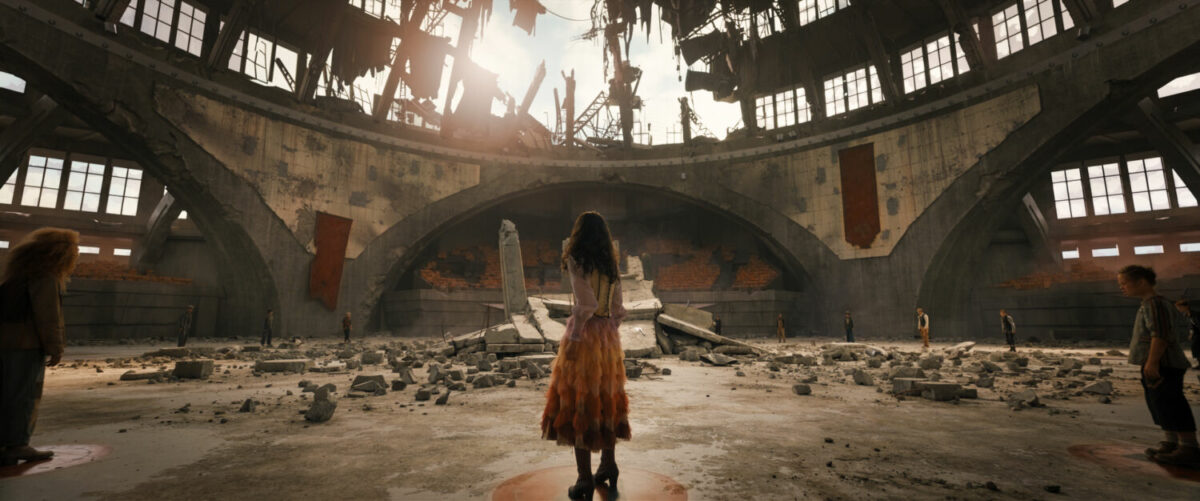Dystopian fiction has always been an intriguing study in interrogating the status quo, serving as a morbid strain of escapism rooted in rebellion, gray morality and ethics, totalitarian regimes, and loss of individuality. The allure of the sub-genre isn’t new, with audiences finding comfort – albeit in a poetically ironic way – in the delicate balance between fantastical imaginations and real, relevant issues facing society.

And as it continued to evolve over the years, Suzanne Collins’ The Hunger Games burst into the scene with a young adult (YA) slant, following The Giver’s footsteps in shaking up an established framework that was previously primarily aimed at adults. The trilogy of novels-turned-movies ended up being a massive hit, paving the way for live-action adaptations of other popular YA books like the Maze Runner trilogy and Divergent series that ultimately failed.
Eight years after Katniss Everdeen’s journey came to an end on the silver screen, the legacy of the Hunger Games remains indelible, which explains the latest entry in the franchise, The Ballad of Songbirds and Snakes. The 2020 prequel from Collins has been eagerly adapted by director Francis Lawrence, who helmed the last three Hunger Games movies and despite having none of the original film actors appear, this movie is a solid reminder of book’s pedigree, weaving together a gripping narrative anchored by phenomenal performances, nuanced characterisation, intricate set design, and high-octane action.
More importantly, it’s a largely faithful execution of the literary source material and aids in enriching the original narrative, though it isn’t free of faults, and there are a few that hold it back from success.

Set 64 years before the events of the original trilogy, the prequel turns back the clock to focus on an 18-year-old Coriolanus Snow (Tom Blyth, Billy the Kid, and played by Donald Sutherland in the earlier films), the last hope of his fading lineage who’s assigned to mentor Lucy Gray Baird (Rachel Zegler, West Side Story) from District 12 for the 10th annual Hunger Games. As the tournament – which would pave the way for his tyrannical reign in the later Katniss-led story – progresses, the pair are forced to unite their instincts for showmanship and political savvy in a race against time, ultimately landing themselves in a romantic entanglement that brings a different set of challenges.
The first thing to know about The Hunger Games: The Ballad of Songbirds and Snakes is that it develops more like a character study than a conventional prequel. In charting the making of a callous, egomaniacal president, it presents a different, never-before-seen side to President Snow: empathetic, sincere, and eager to bring good change, even. But the signs have always been simmering beneath the surface, culminating into paranoia, egomania, and the ultimate sacrifice of love for raw power and ambition.
Blyth, more than adept with his craft, does an excellent job at fleshing out Snow’s character. Oozing charm at every turn, the fresh-faced actor juggles the various facets of his on-screen persona – from warm affection and cool-headed intelligence to guilt-wrecked anguish – with great ease, putting up a convincing show of humanising Snow.

It paints an excellent contrasting stroke to Zegler’s portrayal of the easygoing, confident Lucy Gray, mirroring the incongruent nature of their relationship and different fundamental beliefs of mankind. Stepping into the shoes of a musician, the 22-year-old is very much in her element, and just like her character, effortlessly steals the limelight with her singing performances. “The Hanging Tree” – performed by Katniss in the original – makes a welcome return here, but there are other notable hits as well, including “Nothing You Can Take From Me” and “That Thing I Love With.”
Beyond the music, which features more prominently in the prequel, Zegler also proves proficient at breathing life into Lucy Gray, flitting deftly between her rebellious and emotionally vulnerable sides. In particular, moments of emotional turbulence are sobering, dishing out the reminder that for her bluster and easy charm, she’s only a free-spirited, compassionate teenager at heart. Zegler’s chemistry with Blyth isn’t electrifying per se, but it bears enough rapport to make their relationship feel genuine.
The show-stealer, though, comes in the form of Viola Davis’ Volumnia Gaul, the Gamemaker usually known as Dr. Gaul. It’s a testament to her skill that she manages to command the audience’s attention every step of the way, which is comparatively limited. The revered actress delights as the cruel, sadistic villain here, projecting an intimidating and unnerving aura that promises hell for anyone who goes up against her. Elsewhere, Peter Dinklage establishes himself as another standout, faithfully translating the characterisation of Casa Highbottom to the silver screen.

Despite the 158-minute runtime, The Hunger Games: The Ballad of Songbirds and Snakes doesn’t overstay its welcome for the most part. Sure, there are slow moments, but these are almost always punctuated immediately by high-octane action or a jarring, unexpected turn of events. At its best, the action sequences are a tense and thrilling affair that build up to a high-strung finale. The psychological aspects, meanwhile, offer a different kind of exhilaration, shining the spotlight on mind games, political stakes, and battles between wits.
Like the other entries in the Hunger Games series, this latest film is a brutal, tragic exploration of the nature-versus-nurture conundrum and features many thematic similarities to its predecessors. Think power, greed, morality, the loss of innocence, and more, set against dark narrative overtones. Returning fans will be pleased to find nods to Katniss’ tale, such as mentions of mockingjays, Snow’s proclivity for poisoning his targets, and of course, her plant-based namesake.

With Lawrence back at the helm, it’s no surprise that The Ballad of Songbirds and Snakes continues to be a fairly faithful adaptation of the source material. The major story beats are retained, weaving together a story that’s as gripping as the original, but there are some creative differences that readers have to contend with (no spoilers here!).
The narrative, as a result, experiences some pacing issues in the last arc. Compared to the first two-thirds, the last 30 minutes feels like a rush to the finish line – even if Snow’s story is wrapped up neatly enough. With a longer runtime, the final stretch could have enjoyed a tighter exploration of the character’s psyche as he succumbs to, then embraces, megalomania.
In a similar vein, the romantic development between Snow and Lucy Gray also comes across as fast-moving, with none of the slow burn that goes into establishing an opposites-attract dynamic. For returning fans who skipped out on the novel, the ending may be contentious or unsatisfying, especially if ambiguous or open interpretations aren’t their cup of tea.

Not every villain story is a good one, and The Hunger Games: The Ballad of Songbirds and Snakes falls shy of mastering the craft. That’s perfectly fine, though, as it shoots for the moon and lands among the stars, whipping up an enthralling spectacle that’s equal parts character study, and equal parts cautionary tale. Is it a necessary watch? No. But it does a great job of enriching the original narrative in more ways than one, and for some, that’s what counts. There are only so many good guy stories one can take joy in, after all.
GEEK REVIEW SCORE
Summary
A thrilling return to Panem, The Hunger Games: Ballad of Songbirds and Snakes isn’t the perfect homecoming, but still bears many traces of the same charm and morbid magnetism that bewitched and took the world by storm in the first place.
Overall
8/10-
Story - 8/10
8/10
-
Direction - 7.5/10
7.5/10
-
Characterisation - 8.5/10
8.5/10
-
Geek Satisfaction - 8/10
8/10













